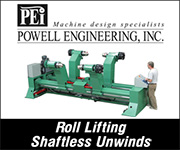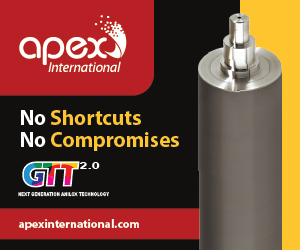Featured Stories
-
-
Elevating Pouch Manufacturing with Pearl Technologies' Cutting-Edge Solutions
For manufacturers seeking efficiency, precision, and safety in pouch production, Pearl delivers unmatched innovation across three standout... -
Faster Product Composition Analysis Equals Better Quality Assurance
Near Instant Testing and Reduced Costs to be Found
News | New Products
-
PACKZ 11 Launches with Industry-First RIP Integration
Plus extended CF2 format and automated support for 2-D Barcodes as Required by the Sunrise 2027 Initiative
-
Double E Group Acquires CAC, Further Enhancing its Strength in the Global Converting Industry
Double E Group, a global leader in converting components and web handling technology, has announced its acquisition of Converter Accessory Corporation (CAC)
-
Nobelus Launches Entry-Level Komfi® Thermal Laminator
FINISHING SOLUTIONS SUPPLIER OFFERS NEW JUNIOR 52 LAMINATING SYSTEM
-
Double E Group Mourns the Loss of Founder and Converting Industry Pioneer, Richard Edward Flagg
Double E Group announces with profound sadness the passing of its founder, Richard Edward “Ed” Flagg, on June 23, 2025. He was 85.
-
Convertech Brand to Fully Transition to Double E Group Same Team, Same Excellence, Unified Name
Double E Group has announced that Convertech, one of its subsidiaries and a trusted provider of core chucks and shaft solutions for the converting industry, will now operate solely under the Double E Group brand.
-
Pulse is Making Print Simple at Labelexpo Europe 2025
Narrow web ink specialist Pulse is Making Print Simple at Labelexpo Europe 2025, as it challenges flexo printers to rethink how they work and shows solutions that turn production bottlenecks into revenue generators.
-
ROTOCON to debut at Labelexpo Europe with three machine demonstrations
ROTOCON will make its Labelexpo Europe debut, exhibiting together with HS Machinery on stand 4D21.
Expert Advice
Water-Based Printing Inks & pH
- Published: December 31, 2004, By Dr. Richard M. Podhajny, Ph.D., Contributing Editor
Material Science
Water dissociates into an equal amount of hydrogen ions and hydroxide ions. The amount of these ions is quite small, but it defines our pH scale. At 25º C, the amount of hydrogen ion (or more correctly hydronium ion) is 10-7 moles/liter. The pH is defined as –log[H30+] concentration.
In the case of water at 25º C, the pH is –log[10-7] or 7. If there are more H30+ ions, the water solution is acidic, and if there are less than 10-7 moles of H30+ ions, then we are alkaline.
In a water-based ink, many of the ink components contribute to the ink pH. For example, the common acrylic resins used in water-based inks are acidic. They are not soluble in water but are soluble when alkaline materials are added.
When these acidic resins dissolve in alkaline water, they become neutralized and form soluble salts. The solubility is dependent on the pH. If the pH drops, the resins will tend to become less soluble and may "kick out" of solution.
Pigments are insoluble, but they depend on the pH for their fine particle stability. Dispersing resins and agents form salts around the pigment particle, which enhance the pigment stability through like-charge repulsion between particles. Since some pigments are salts themselves, pH compatibility evaluation is essential.
Likewise, resin emulsions can be selected that are more stable in alkaline conditions.
Most water-based ink systems use ammonium hydroxide and volatile amines to control and maintain alkaline pH in the ink. Since often they are volatile, other alkaline additives or buffers can be added to help maintain pH.
In reality, every component of the ink must be tested for optimum performance of the working pH range of the ink. Most water-based inks run at an alkaline pH of 8–9.5. However, ammonium hydroxide is quite volatile, so pH will drift down unless appropriate formulation steps are taken to buffer the pH range. If the pH is allowed to drift down, the ink will increase in viscosity, build up on the printing plate, and produce unacceptable levels of foam. In addition, the high levels of ammonium hydroxide can create high levels of "ammonia" odor.
Problems associated with a drop of pH are commonplace. Since the viscosities often increase with a drop of pH, foaming and print quality may deteriorate. Dirty printing is a term often used to describe ink prematurely drying on the flexographic printing plate and casing the print to show a ragged edge or spots near the print edge.
Several years ago Eastek (Eastman Chemical) came out with a new breed of water-based inks that could be run essentially at neutral pH. This technology was based on a new class of sulfonated polyesters that were dispersed in water.
Since the resins did not depend on solubility in an alkaline medium, they could be formulated in inks with near neutral pH. These sulfonated polyesters were essentially resin dispersions and typically had low viscosities. Although the technology has numerous advantages, it also has some limitations and has made minimum penetration into the conventional water-based ink market.
Today, ink formulators are developing water-based inks that can be run at lower pH with an ultimate goal of formulating inks that will run at neutral pH. New resin binders with lower acid numbers and lower VOCs are being investigated. These inks are similar to high-pH acrylic types but can be formulated with resins with lower acid numbers.
Balancing water-resistance in the printed product with lower-pH inks is a challenge. These inks must provide the same adhesion and water-resistance yet use resin binders that essentially use less ammonia. These new pH-neutral types of water-based inks still are alkaline soluble, but they can function at a lower pH range and with a wider operating window.
The objective is to have these inks run on press without the need of pH adjustment. An added bonus is that press cleaning should be easier, and less foam should be generated.
The driving force for developing neutral pH inks is to reduce press-side odor from ammonia and improve press stability and performance.

Dr. Richard M. Podhajny has been in the packaging and printing industry for more than 30 years. Contact him at 267/695-7717; rpodhajny@colorcon.com.






















